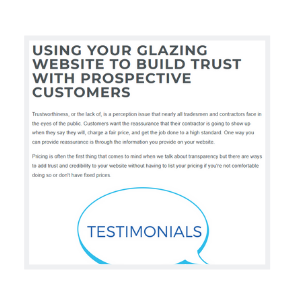Your glazing website's homepage has to serve a range of purposes: entice viewers in, inform and educate them about your glass business, help you stand out from the competition and direct the viewer where they need to go, no matter what device they're viewing it from. We've put together some ideas below to help you decide whether your home page is meeting your customers' needs.
.png)
Make it easy to get from A to B
When a customer walks into your glazing business or calls you on the phone, they're able to ask a human for information and get the answers they're looking for. Your website home page needs to do the job of that human for customers who visit your website as their first point of contact.
Often, we are too focused on making sure the home page looks good rather than testing how it functions. One helpful method for testing how easy it is to find information on your website is to map out pathways on a whiteboard or paper. Here's an easy method to try:
- List the reasons a user would be visiting your website - perhaps they are looking for a specific service, pricing information or want to know if you're available in their area, for example
- For each of the reasons, start at the home page and figure out how the user would get to the information they need to map
- Map out each path so you can see exactly how many steps and variations there are for the user to find what they need
If there are more than three steps from the home page to find the answer they need, consider how you could make this process easier for the user.
Once you've made changes, test them by getting friends and family to find information on your website without you guiding them, it's a great way to pinpoint where people may be getting stuck and the kind of search words they use.

Make sure your home page looks good on all devices
We often rely on our computers to look at our company website but it would be a mistake to assume our website visitors are doing the same. This is especially true if your glazing business does emergency repairs - your customers are highly likely to be looking you up on their phone. If your website isn't 'responsive' (automatically resizing to fit the device) then it's time to consider talking to a web developer and getting an upgrade.
Here are a few things to keep in mind for mobile devices:
- Ensure any images you used are 'compressed' (reduced file size) so they load quickly on mobile and don't require a lot of the user's data
- Keep contact forms as short as possible and use large fields and buttons so they're easy to navigate
- Experiment with stretching and shrinking your browser to see how your website displays at different sizes
- Test your website on different browsers to make sure it works correctly on all of them i.e. Chrome, Firefox, Internet Explorer, Safari, etc
.png?width=560&name=More%20blog%20imagery(1).png)
Make it pretty
Your home page should be functional first and foremost but design is important too. We've become so accustomed to browsing the web that it only takes a couple of seconds to make a snap judgment - we can tell quickly if a website looks dated or unloved, or if it's too cluttered or difficult to navigate. Here are a few simple design ideas to keep in mind:
- Ensure you pick a font that is easy to read. Here are some accessibility guidelines that will ensure your website caters to all users: Web Accessibility Initiative (WAI)
- Break up sections of content with bold headings. Not only does it make it easier for the user to skim read, using heading tags is good for your website's SEO
- Use high-quality images. Using real-life photos is great but make sure they're taken on a quality camera or hire a professional to take a few for you. If you use stock imagery, pick images that don't look overly staged or inauthentic (try unsplash.com for free, licensed stock images)
- Sometimes less is more. Having plenty of white space (or negative space) on the page gives our eyes space to rest and draws attention to the elements you do have on the page
.png?width=560&name=More%20blog%20imagery(3).png)
Do your homework
There's no need to reinvent the wheel, do your homework and look at other websites for ideas on what would work best for you. There's a reason so many website home pages have a similar structure - the formula is tried and true. For basic home page structure, try this article: 10 Elements of a Successful Website Homepage Design.
If you decide to overhaul your existing website, make sure you talk to a variety of web developers and get a range of quotes. It's important to have a fixed budget and outcome in mind to begin with as web projects can quickly add up if you're making changes along the way.
If you're looking for inspiration for your website, check out these articles for ideas:
- 15 Examples of Brilliant Website Homepage Design
- Best Contractor Website Designs for 2018
- 21 of the Best Examples of Mobile Website Design
 what to read next
what to read next
Check out this article we wrote about using your website to help your customers build trust with your glass business.
You can also filter all of our articles to just see articles about marketing your glazing business.




